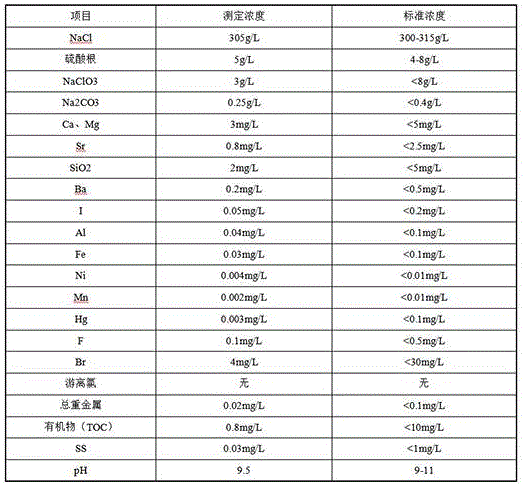Method for refining and resource utilization of byproduct salt
A by-product and recycling technology, applied in chemical instruments and methods, chemical/physical processes, solid waste removal, etc., can solve the problems of resource utilization of bonding equipment, uneven heating, etc., to increase heat energy utilization, heating The effect of uniformity and shortening of heating time
- Summary
- Abstract
- Description
- Claims
- Application Information
AI Technical Summary
Problems solved by technology
Method used
Image
Examples
Embodiment 1
[0035] The process flow of the present invention is shown in Figure 1. The by-product salt used in this experiment comes from a pesticide chemical company. It is mainly the by-product salt (primary filter salt) produced in the production process of insecticidal sheets, and the main component is sodium chloride salt. The water content of the sample is about 12%, and the concentration of organic matter is relatively high. A certain amount of by-product salt was weighed, placed in a microwave cracking furnace, the temperature was set at 400°C, and the cracking time was 4 hours. The treatment effect is shown in Table 1.
[0036] Table 1 Experimental processing and analysis data
[0037]
[0038] Remarks: The data is measured by dissolving 10g dry weight by-product in 100ml pure water.
[0039] It can be seen from the data in Table 1 that after microwave cracking, the salt organic matter in the by-products has been lower than the detection blank, indicating that the organic mat...
Embodiment 2
[0051] The by-product salt used in this experiment comes from a pesticide chemical company, which is mainly the by-product salt (primary filter salt) produced in the production process of insecticidal sheets, and the main component is sodium chloride salt. The water content of the sample is about 12%, and the concentration of organic matter is relatively high. Weigh a certain quality of by-product salt, place it in a microwave cracking furnace, set the temperature at 600°C, and crack it for 2 hours. Dissolve the qualified salt in a certain volume of solution. The salt concentration in the solution is 200g / L. A good salt solution for removal of impurities.
[0052] (1) clarification and filtration. Dissolved salt contains a large amount of insoluble sediment and carbon compounds, which need to be removed.
[0053] (2) Remove sulfate ions. Add barium salt to the solution, when sulfate ion and barium ion form barium sulfate precipitation, thereby remove sulfate ion by the form...
Embodiment 3
[0058] The by-product salt used in this experiment comes from a pesticide chemical company, which is mainly the by-product salt (primary filter salt) produced in the production process of insecticidal sheets, and the main component is sodium chloride salt. The water content of the sample is about 12%, and the concentration of organic matter is relatively high. Weigh a certain quality of by-product salt, place it in a microwave cracking furnace, set the temperature at 200°C, and crack it for 6 hours. Dissolve the qualified salt in a certain volume of solution. The salt concentration in the solution is 350g / L. A good salt solution for removal of impurities.
[0059] (1) clarification and filtration. Dissolved salt contains a large amount of insoluble sediment and carbon compounds, which need to be removed.
[0060] (2) Remove sulfate ions. Add barium salt to the solution, when sulfate ion and barium ion form barium sulfate precipitation, thereby remove sulfate ion by the form...
PUM
 Login to View More
Login to View More Abstract
Description
Claims
Application Information
 Login to View More
Login to View More - R&D
- Intellectual Property
- Life Sciences
- Materials
- Tech Scout
- Unparalleled Data Quality
- Higher Quality Content
- 60% Fewer Hallucinations
Browse by: Latest US Patents, China's latest patents, Technical Efficacy Thesaurus, Application Domain, Technology Topic, Popular Technical Reports.
© 2025 PatSnap. All rights reserved.Legal|Privacy policy|Modern Slavery Act Transparency Statement|Sitemap|About US| Contact US: help@patsnap.com


